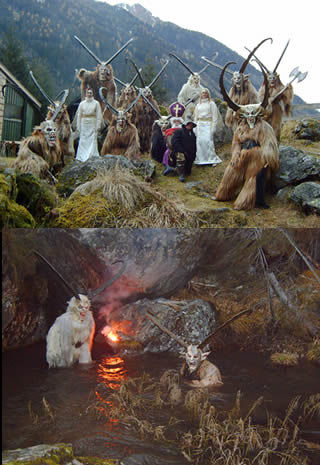It seems you can’t swing a dead cat these days without smacking into Krampus, the dark shadow to the bright light of St. Nicholas at Christmastide. The ancient Alpine demon-thing comes equipped with horns, fangs, claws, unruly fur, hooves, long creepy tongue; and wields chains, whips, switches, and bells. And while the punisher of naughty kids has been terrorizing Germanic Europe for centuries, even millennia, he is now suddenly running rampant across the US in a brand new feature film, on TV (Grimm, Supernatural, Colbert Report, American Dad), in comics and novels, and at various gatherings, balls, and runs.
Not too long ago, the naughty list of Santa Claus actually meant something: if kids misbehaved they were punished for their misdeeds by being given the dreaded lump of coal, or at least denied longed-for presents from Santa. Kids had something to think about, something at stake, Christmas bounty wasn’t automatic. But over the last century or so the stick has disappeared from the carrot-and-stick approach to Christmas. When Vince Vaughn-as-Fred Claus intoned in 2007, “There’s no naughty kids, Nick. They’re all good kids. But some of them are scared. And some of them don’t feel listened to. Some of them had some pretty tough breaks too. But every kid deserves a present on Christmas,” that coffin was nailed shut.
The zeitgeist senses that something is missing, that Christmas is out of balance, that actions no longer have consequences. Hence the resurgence of Krampus in his ancestral territory of Austria, Germany, Switzerland, Slovenia, Hungary, and the Czech Republic, but also in the US. And when Americans grab onto a trend, it knows it has been grabbed.
As with many Christmas traditions, the origins of the scary fellow predate Christianity and reach back to ancient pagan times. The name “Krampus” comes from the German krampen, which means “claw,” and this guy has them. One legend has it that he is the son of the Norse god of the underworld, Hel. Originally, Krampus and his ilk were associated with the winter solstice and were on hand to scare away the evil spirits of winter, sort of like ambulatory gargoyles. So while he was terrifying, he served a beneficial purpose and was thus also viewed with a certain amount of affection. “He may be a monster, but he’s OUR monster.”
That affection was on display in Krampus postcards that were very popular in Austria, Germany, and the Alpine region between the late 19th century and World War I, resounding with the cheerful threat of Gruss vom Krampus (“Greetings from Krampus”). While originally directed at scaring kids straight, the cards soon diverged into humorous, often wildly grotesque behaviors and personalities, including Krampus women.
Historically, as the Christian era came to swallow pagan rituals in the Middle Ages, Krampus came to be associated with St. Nicholas — talk about strange bedfellows! — and his actions were centered around Krampusnacht (“Krampus night”) traditionally held on December 5, the eve of St. Nicholas Day, December 6. While the generous saint gave out treats and small toys to the good kids, Krampus took draconian punitive measures, beating the naughty kids with birch switches, stuffing the truly bad kids into his vile sack and dragging them back to his lair to be boiled, eaten, and/or tossed into the pit of Hell. Shizzle. Over the ages, many attempts have been made to suppress Krampus by everyone from the Catholic Church to the Nazis, but you can’t keep a good demon down.
In the modern era, Krampus activity has centered around Krampusnacht processions, where men adorn themselves in multifarious Krampus garb and masks and parade through Austrian, German, and Hungarian towns threatening and menacing all in their path and perhaps tossing back a schnapps or five. In some towns and villages things get personal and the Krampi go door to door of houses with children, so there is no escape! There is even a Krampi gauntlet, where the kiddies have to dodge a range of attempted assaults on their person before being rewarded after they escape.

In the US awareness of Krampus was given a huge boost in 2004 when Monte Beauchamp published Devil In Design, a collection of more than 150 vintage Krampus cards from Austria and Germany. His Krampus: The Devil of Christmas is an outstanding primer on the phenomenon. Of the Krampus-related organizations in the US, Al Ridenour’s Krampus Los Angeles seems to be the most dedicated to the traditions, artistry, and serious exploration of Krampus themes.
The just released feature film Krampus had a very solid box office opening, may be on its way to becoming a holiday staple, and is not without charms, but it has very little to do with the actual Krampus character, behavior, origins, or role in Christmastide. Oh well.
READ MORE “WEIRD CHRISTMAS”:
Talking Weird Christmas Customs with Gerry Bowler on After Hours AM/America’s Most Haunted Radio
Werewolves of Yule
Mari Lwyd – The Party Animal Horse Skull of Wales
Talking Krampus with Novelist Richard Kadrey on After Hours AM/America’s Most Haunted Radio
The Yule Log
The Macabre Adventures of St. Nicholas
Santa Claus and the Magic Mushroom
Midnight Syndicate on After Hours AM/America’s Most Haunted Radio
Midnight Syndicate Brings Spooky Sensibility to CHRISTMAS: A GHOSTLY GATHERING
SCROOGED Should Be On Your Christmas Horror List
















Share This
Share this post with your friends!